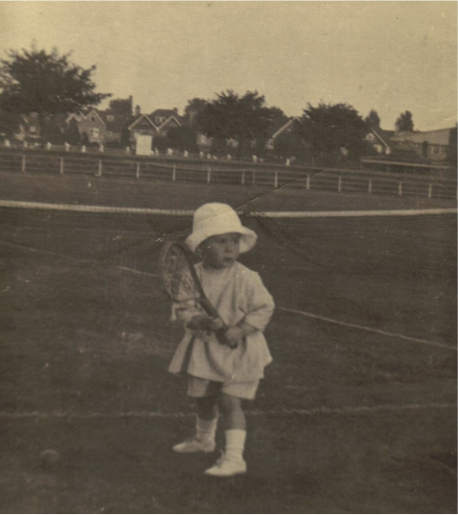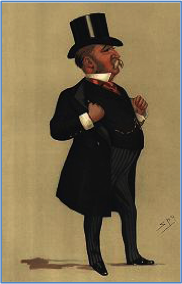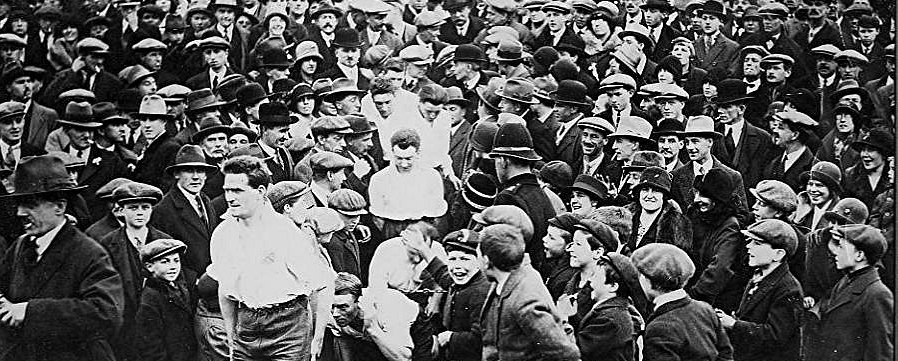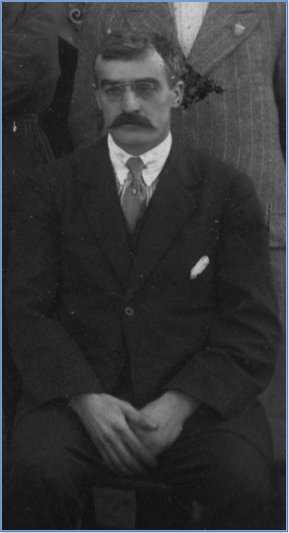Following the departure of the military from Clarence Park , in 1919, and prior to the return of the football club, plenty of effort had been made to return the playing surface of the football ground to its former highly regarded condition. Once the re-instatement of the pitch was completed it was described as ‘a really good playing area which is free from ruts, and is conducive to fast play.’
Prior to the outbreak of war St Albans City had attracted four-figure crowds at a ground that was bereft of terracing and housed a main stand that could seat just 400 spectators. To keep spectators from walking on wet grass and mud, duck boards were laid around the perimeter of the pitch.
By the time that World War II had begun the football ground at Clarence Park had undergone major alterations and improvements. Success on the pitch was matched by strident changes off it, as the stadium was transformed into one of the grandest amateur grounds in the south of England.
The improvements, which took in installing terracing, extending the main stand, and building dressing rooms into the main stand, were carried out throughout the 1920’s.
In the spring of 1921 the Club made an unsuccessful application to its landlord, the St Albans council, for a lease on its Clarence Park home. Instead, the City went into the new season under the same terms of the previous season with an annual rent of £150.
One of the reasons why the Club wanted the lease was to gain greater control over who could have use of the pitch. At this time in the history of the Club the pitch was given over to the playing of tennis during the close season, something that St Albans City wished to bring to an end.
 Left : Lifelong City supporter Peter Hollingsworth plays tennis on the football pitch in the mid 1920’s.
Left : Lifelong City supporter Peter Hollingsworth plays tennis on the football pitch in the mid 1920’s.
Despite failing to get the lease and the control of the ground that it sought, the Club then presented plans for the installing of terracing.
In May 1921, the following was recorded at a meeting of the Park’s Sub-Committee. ‘The idea is that, in order to find work for the local unemployed when the Waverley Improvements are completed, the asphalt running track around the cricket pitch shall be levelled and turned and that the material thus removed shall be utilised in the construction of terraces around the football field so as to give spectators better opportunities of witnessing the play than are now afforded the crowd, on level ground, around the ropes.’
Two months later, in July, worked commenced on installing the terracing, which consisted of four steps, each three feet wide. Each terrace was to be supported by railway sleepers. The sleepers cost £70 and were funded by the football club.
Access to the terraces would be via steps built into the banking facing away from the football ground. The players, who were still using the dressing rooms in the cricket pavilion at this time, would also gain access to the ground in this manner.
The project, however, was beset with problems. The manpower was provided by the council, but when the corporation ran out of funds in mid-August the scheme was put on hold. Fortunately, an application to the Ministry of Labour was successful and work was resumed by the end of the month.
The terrace opposite the grand stand was completed by mid-October, with the remaining two sides installed by the start of December.
The new-look stadium was used for the first time on Thursday 8thDecember for an FA Cup 5th Round Qualifying replay against Nunhead. The attendance was 3,500 and the locals went home looking forward to a trip to Gillingham in the next Round after goals by George Meagher and Ted Miller secured a 2-0 win for the Saints.
It was claimed that the attendance was just one-third of the new capacity, but, given that the main stand had yet to be extended and currently housed just 400 spectators, this figure appears fanciful.
The following year, 1922, saw the main stand undergo a dramatic refurbishment. The original pavilion was 104 feet long; this was increased to 290 feet, taking its capacity from 400 to 1,500. A further 200 seats were provided by a bench that ran the length of the front of the building.
The total cost of the scheme was £1,300. The success that the Club had enjoyed since the end of the war led to a healthy balance in hand at the bank, and £1,000 was put aside for the redevelopment of the stand. The remaining £300 was loaned to the Club by Mr D. Martin. In spite of providing a facility that would immediately become the property of the local corporation, Club officials were adamant that not a single penny of public money should be used to fund the project.
 The original enclosure, built in October 1894, had been financed Sir John Blundell Maple (right). And it was Sir John, the Member of Parliament for Dulwich and owner of the Maples furniture store in Tottenham Court Road, who had presented the park to the city in July 1894.
The original enclosure, built in October 1894, had been financed Sir John Blundell Maple (right). And it was Sir John, the Member of Parliament for Dulwich and owner of the Maples furniture store in Tottenham Court Road, who had presented the park to the city in July 1894.
Sir John had some spare income at this time after his horse, Childwick, had won the Cesarewitch at Newmarket on 10thOctober. Childwick was named after Sir John’s home, the luxurious manor house at Childwickbury, situated between St Albans and Harpenden. His winnings from this race were £1,035, of which £100 was used to fund the wooden enclosure at Clarence Park .
Speaking at the St Albans Athletic Sports Committee Annual Dinner at the Peahen Hotel, Chequer Street, on Friday, 12thOctober 1894, two days after the race, Sir John included the following words that were very much of the era.
“We do not want an elaborate building, but one which will enable ladies to remain in the dry should the elements prove unfavourable, and for admission to this pavilion an additional 6d or 3d could be charged. As you all are aware, I am most anxious that this ground shall be a success.”
The pavilion, which housed 400 spectators, did not have chairs that were fixed to the structure, but loose ones that were back in place in time for the start of the 1920-21 season; City’s first season as full members of the Football Association.
The plans for the redevelopment, unveiled in May 1922, detailed that the existing pavilion would be extended by 106 feet towards the Midland Railway (Hatfield Road) entrance, and 80 feet towards the York Road gate.
The existing ends of the pavilion were to be removed and reinserted onto the extended structure. The plans suggested that the six tiers of seating would be raised at one foot levels, but this was later reduced to nine inches.
The work was carried out by local contractor Tommy Wiggins and hundreds of interested local citizens went along to look at the development at weekends. Despite the seemingly huge interest, season tickets were not issued for the forthcoming season, as deposits for tickets reached only one-quarter of the target set by the Club.
The stand, although not yet complete, was opened to the public for the first practice game on 19th August. For a friendly against Tottenham Hotspur Reserves, on 23rd September, a Club flag, donated by councillor J. Buckley-Robinson, was flown from the centre of the new stand for the first time.
It was to be a further two years before the final touches were put to the stand when the committee accepted an estimate of £45 15/- from Mr H.W. Smith for the adding of backs to the seat benches. A further £6 was spent at this time on repairing the footpath in front of the main stand.
Below: City captain Harold Figg leads the team from the dressing room in the cricket pavilion and down the terraces onto the pitch for a quarter final Amateur Cup tie against Ferryhill Athletic on 27thFebruary 1926. The match attracted the record Clarence Park attendance of 9,757.

From the opening of the Park, on 23rd July 1894, until 1929 the footballers had changed in the dressing rooms inside the cricket pavilion, as such facilities did not exist in the football ground.
But, during the summer of 1929, some 35 years after the Park was given to the citizens of St Albans, the football club moved into the modern era with the installation of dressings rooms constructed within the main stand.
 The work was carried out by people connected to the football club and under the leadership of Arthur William Marshall (left). Mr Marshall served the Club in two spells between 1912-34. He was Hon. Secretary when the City moved from the Athenian League to the Isthmian League in 1923. However, he was most vehemently against the move and resigned his position. He returned as an official three years later and spent four seasons as the City club treasurer.
The work was carried out by people connected to the football club and under the leadership of Arthur William Marshall (left). Mr Marshall served the Club in two spells between 1912-34. He was Hon. Secretary when the City moved from the Athenian League to the Isthmian League in 1923. However, he was most vehemently against the move and resigned his position. He returned as an official three years later and spent four seasons as the City club treasurer.
When the construction of the dressing rooms was undertaken, a contract was signed stating that the work should be completed by 30th September. The first game for which the new facility would be used was due to be against London Caledonians.
Unfortunately, the original deadline was not met and the grand opening was delayed until the visit of Kingstonian for an Isthmian League fixture on Saturday 26th October.
The Mayor of St Albans, William S. Green, had the privilege of conducting the opening and received from Mr Marshall a silver ink stand bearing the inscription, ‘St Albans City Football Club. Presented to Alderman W.S. Green J.P. on the occasion of the opening of the new dressing rooms, Clarence Park , 26thOctober 1929’.
The new rooms totalled eighty feet in length and approximately twenty feet in depth. The dressing rooms consisted of deep baths and shower facilities whilst on the entrance to the pitch the tunnel had two further rooms. One room housed the boiler, while the other provided an office for the secretary, there was also a telephone box. All of which combined to give City some of the most modern and impressive facilities in the amateur game. The facilities would have been even grander had the original plans been followed through as the intention was to build a clubhouse on top of the main stand. This, however, was not carried out until four years after the end of the Second World War.
The opening ceremony of the dressing rooms attracted a healthy attendance of 3,000, but Kingstonian spoilt the party by taking home both points with a 4-2 win.
The new building almost suffered a far greater setback on the 16th November. Mr W. Collins, superintendent of Clarence Park , spotted smoke coming from the roof at 7pm of that evening. Single-handedly he climbed on to the roof and extinguished the flames with buckets of water.
When the fire brigade reached the ground they opened up the roof to discover one of the beams smouldering away. They distinguished that before the whole place could go up in flames. But for the intervention by Mr Collins there is no doubt that the dressing rooms and the main stand, would have caught alight and been razed to the ground.
For training that week the players had to once again get changed in the cricket pavilion. By discovering the fire at an early stage the damage was limited, and the players were back in the football ground dressing rooms come the next match; a 5-3 win over Woking on 30th November.
The dressing rooms suffered a further mishap later in the season when, on 28th April, an intruder broke into the building. The would-be thief scaled the lattice metal gate at the entrance to the tunnel and is believed to have searched both dressing rooms and a cupboard, before leaving empty-handed through the referee’s dressing room window. He then smashed his way into the tea chalet in the main park, whose owner, Alan Manners of Upper Culver Road, said that the till had been broken into and stock disturbed but he was not certain whether anything had been stolen.